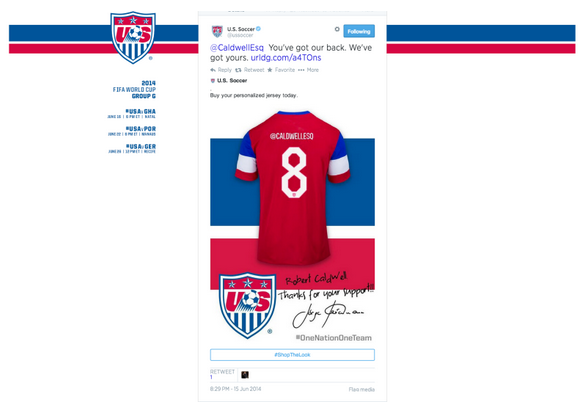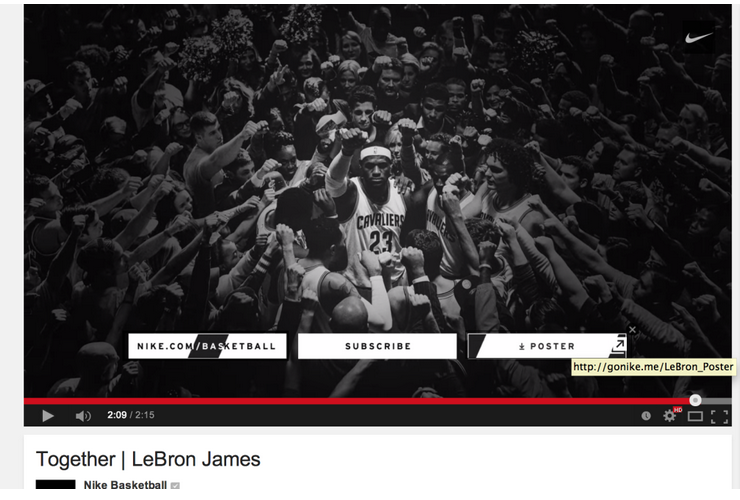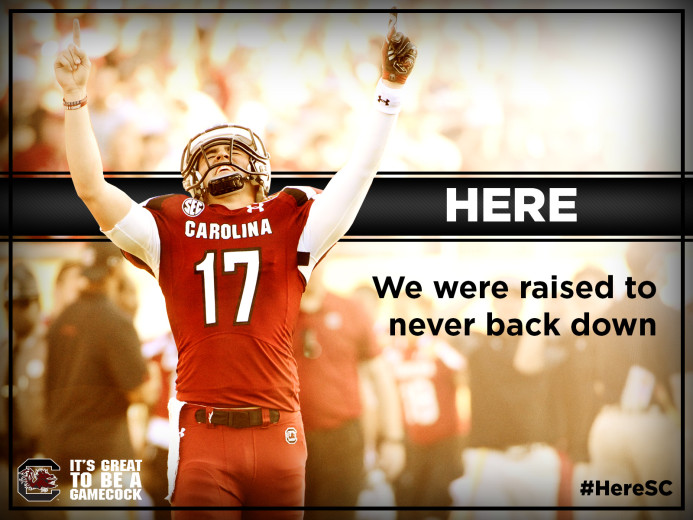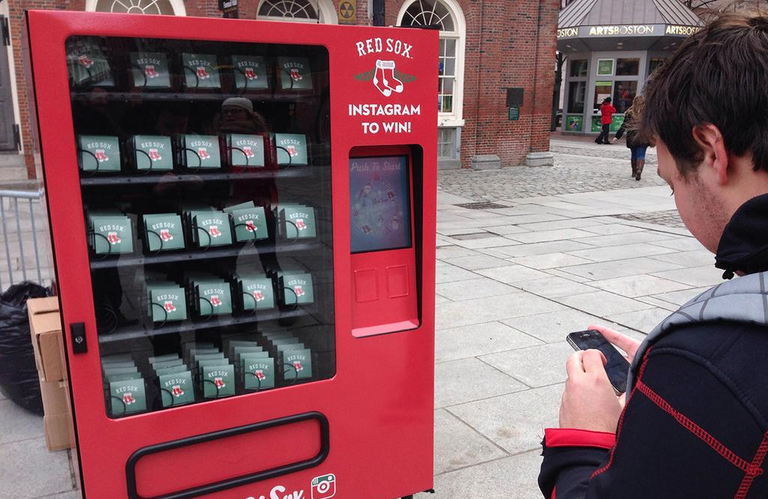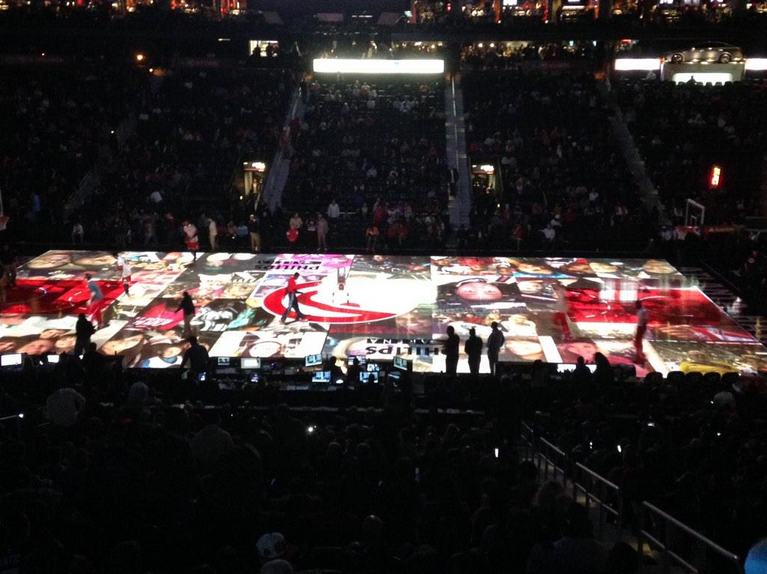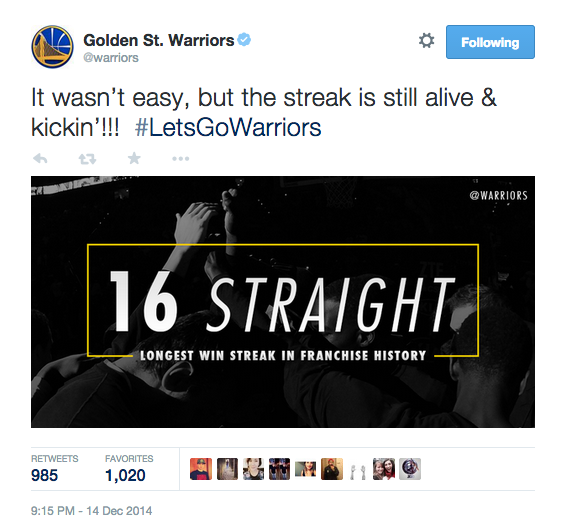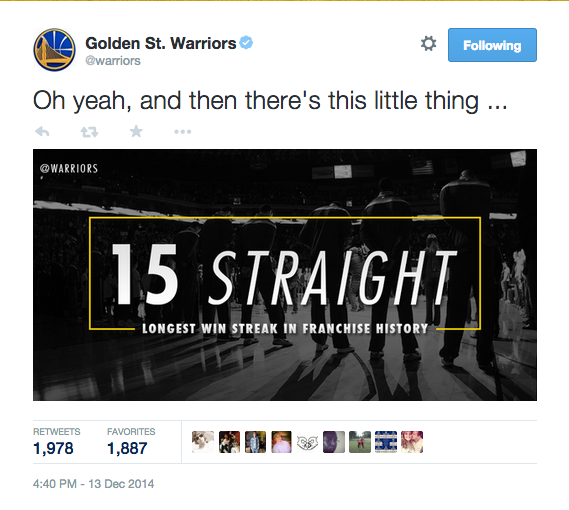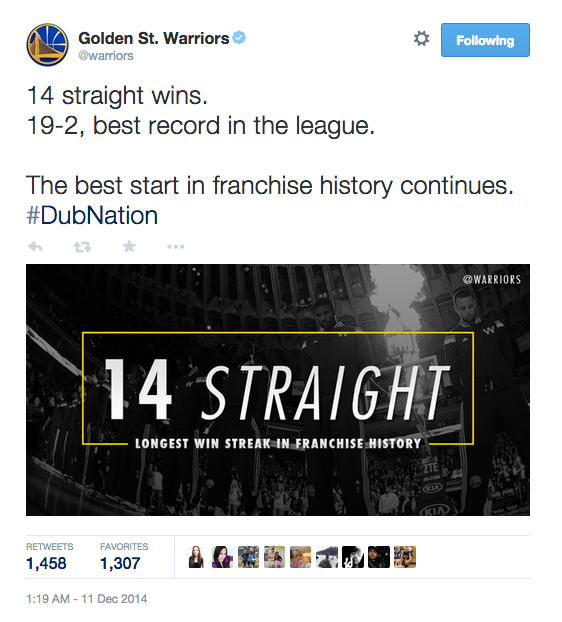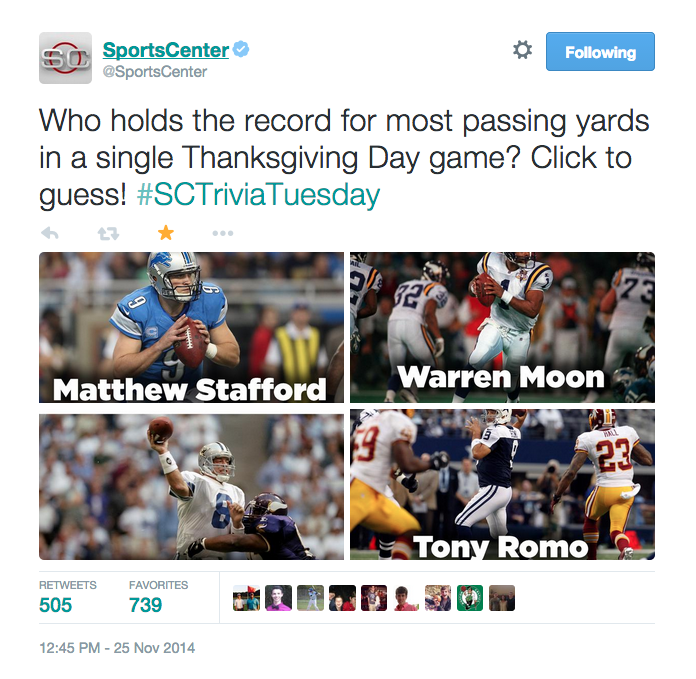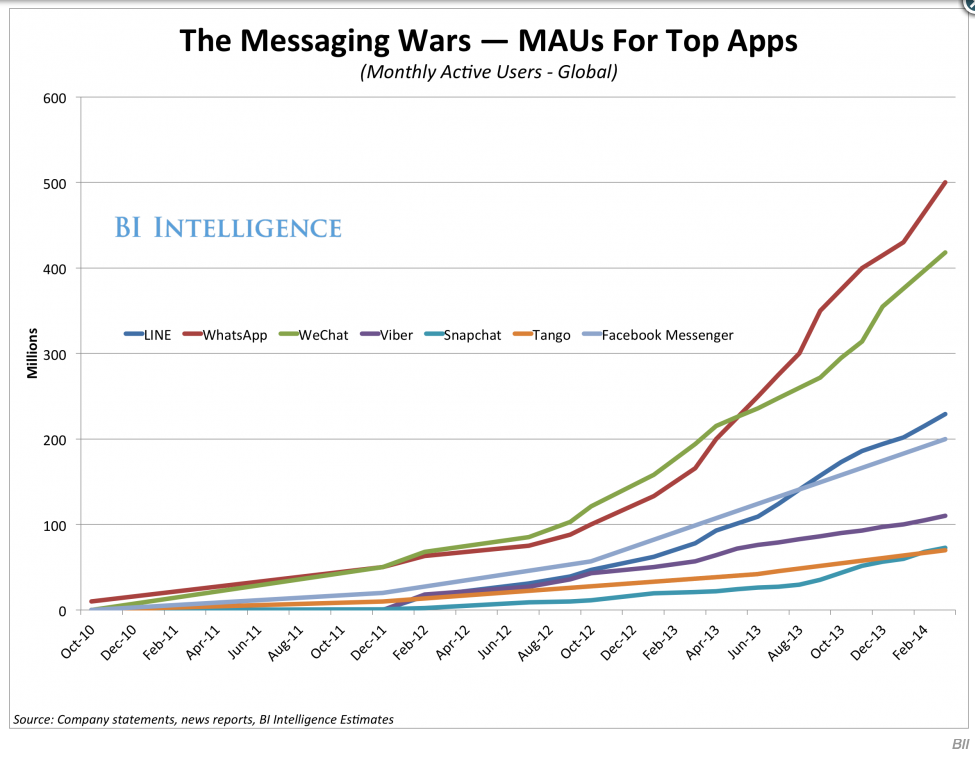It’s time to tackle social media trends for the year ahead. This isn’t meant to be a forecast of what’s to come per say, but a list to get you thinking about what you want to do in the New Year. I realize everyone’s goals and objectives are different, but hopefully there is something here that will align with what you want to accomplish. Without further ado, here are 15 things I would like to see in social media and sports in 2015:
No. 1- A personal approach to fans.
@USSoccer dominated on Twitter during this year’s World Cup. From a huge influencer program to stellar content, they rocked it. One of my favorite initiatives from @USSoccer was the personalized, digital jerseys (and yes we’ve seen many others follow suit since then):
I love the idea of creating personal experiences for fans because it’s a great way to “thank” them. I do realize the sports industry is fortunate: For the most part, you don’t have to beg and plea for people to pay attention. Even then, teams shouldn’t neglect fans. There will be highs and lows with teams. Social is a great opportunity to foster dedicated fans that don’t stray even when the team isn’t winning.
A personal approach to fans doesn’t have to mean personal content either. There are many initiatives where teams can surprise and delight fans through a personal touch:
- Tweet a coffee to a dedicated social fan on a cold day.
- Give someone a seat upgrade “just because” you saw them tweet from the game
- Have a player write a handwritten note to a “super fan” and then tweet a picture of it to the fan
- Personal photograph souvenir by turning a fan photo into a branded piece of content (like this example from the Seahawks)
The bottom line is this: In 2015, let your fans know you appreciate them through your online interactions. If you do, you’ll encourage them to spread your team’s love even more.
No. 2- Maximization of Facebook.
Facebook gets a lot of flack it does not deserve. Despite all the gloom and doom, it’s still the king of social media platforms. Facebook has a 90%+ reach across all ages 18 – 64. That’s pretty impressive. Facebook is still the place to play if you want to reach the largest audience,
Instead of whining about changes and falling organic reach, look in the mirror and ask if you are making the most of Facebook. Are you sharing quality content? Are you playing to pay in a strategic way? Are you leveraging the targeting options? If you want success on the platform, then you need to be able to say “yes” to all these questions. Make sure you leverage Facebook for all it has to offer in 2015.
No. 3- Interactive video.
We all know the importance of video by now. YouTube reaches more US adults ages 18 – 34 than any cable network. It’s time teams and leagues maximize their engaged audience on YouTube by leveraging annotations (clickable overlays) or an interactive video platform (choose your own path video). Doing so can help increase engagement, subscribers and make fans take action.
An example of this is from Nike: They used YouTube annotations for their LeBron video this year to drive consumers to a poster:
The simple action of clicking to download a poster is something that translates really well to teams, leagues and others in the sports industry looking to share game schedule posters, title / championship posters, TV schedules, etc. What’s the best part? YouTube allows you to add annotations to videos for free. It’s time to take advantage of them.
No. 4- Campaigns each season.
I would love to see teams and leagues think of each season as a new brand campaign. What is your team’s story this year? What can you rally your fans around?
Take a step back before each season begins and plan a “campaign”. Focus on the team’s story that season, the look and feel of your graphics, the rallying points (hashtags, phrases, etc.), content series, etc. There’s power in thinking about each season as a campaign because it differentiates content year after year, builds anticipation / story lines and gives focus to the content.
An example of this is South Carolina’s “Here” campaign:
No. 5- Convergence of the physical and digital worlds.
Teams looking to enhance the gameday experience need to give a hard look at experiential marketing. In its simplest form, experiential marketing helps to bring a brand to life in the physical space (i.e. the team) through a memorable experience. A great example of this is the Red Sox vending machine where fans tweeted for tickets:
Another play in bridging the gap between social and the physical world is repurposing social media content for in-venue. Below is a great example from the Hawks where they displayed Instagram photos on the court:
Focus on bridging the gap between the social and digital world in 2015.
No. 6- A brand voice all your own.
One of the trends I wanted to see in 2014 was more personality from teams and leagues. And yes, we saw a lot more personality in social media + sports, but a lot of what I we saw was snark. It seems that there’s a misperception that brand personality means you have to be snarky. That’s not the case.
Brand voice is hard to define. I get it. But here’s a clue that you’ve nailed it: If the social media manager leaves today, and the rest of the team wants the tone and language to stay the same, then you’ve found your voice. The entire organization (top down) should buy into brand voice, especially snark. Your social media accounts reflect your brand across the board.
In 2015, I would like to see teams take a step back and actually think about what brand voice means. Find your own and know that you don’t always have to resort to gimmicks.
No. 7- Content series.
This year we saw the start of a new trend: Designing a look and feel for certain moments. Think end of quarter score updates, tip-off information, big milestones, post-game presser quotes, etc. I like this trend: Not every photo needs intensive labor, but if you have several areas where strong visuals make sense, it helps the content to stand out from all the noise. I hope we continue to see much more of this in 2015. Sharp and consistent content like the series below will help your content stand out:
Want more inspiration? You can get some here.
No. 8- Content for each platform (with mobile in mind too).
There are two parts to this thought. First, it’s time to create (or at least tweak) content for each platform. Stop hitting fans with the same content across all platforms over and over and over again. Take the time to differentiate from platform to platform, keeping in mind the audience, how consumers use the platform and what tends to resonate. Even if you want to share a photo after a win, consider sharing different ones across each platform. I’m sure you have more than one great shot to share after a big win. Why not use them all? In 2015, we need to think about our content strategy and how we can create or tweak content for each platform.
Second, it’s time to design with mobile in mind. Facebook now has 1.35B monthly active users, 864M daily active users and 703M mobile daily active users. Time spent on mobile surpassed TV this year for the first time. Mobile is big. Design with it in mind.
No. 9- Quality video.
Video content is huge these days. To get good traction though, teams need to do it the right way. In 2015, it’s time to throw out the boring talking heads and the idea that you have to churn out video content daily. Focus on creating quality video instead. I want to see more thoughtful and personal storylines, quality production and content that taps into emotion. Even in this fast-paced world, it’s worth taking the time to do video content right.
Interested in some video inspiration? Here you go.
No. 10- Less FOMO.
Bryan Srabian said it best in the lessons learned in 2014 post: Let “My Way” be your mantra. In 2015, I want to see less fear of missing out. You don’t have to jump on every new platform, tweet every game action and hijack the holiday conversations.
You can’t do it all and that’s okay. Let’s stop fearing the chance we might miss one fleeting moment. Instead, focus on generating smart, funny, emotional, great and compelling content — that’s on brand– 365 days a year. Let’s stop fearing that we’ll be last to the party if we don’t jump on the latest platform. Instead, let’s take the time to understand the why behind what we are doing. In 2015, stop fearing that we might miss out and focus on accomplishing the goals ahead.
No. 11- A content-first approach.
Repeat after me: Your role expands far beyond the platforms. Content is king, so a good social media strategy starts with a content strategy. Platforms may come and go, but the need to communicate and tell a story online is here to stay.
In 2015, start thinking about all the ways you can keep content fresh and interesting. It’s not all about text, photos and videos. The opportunities with content are endless, from photo essays to Twitter quizzes (like this example below):
Start thinking about all the types of content you can create to tell a more cohesive story. And, if you feel like you’re in a content rut, then this guide can get you started.
No. 12- Data to focus on what matters.
The sports world doesn’t struggle with content. I would argue that it has the opposite problem: There’s too much content to work with. In 2015, I would love to see the philosophy that less is more. This will allow you to focus on quality. You have x number of games a year. You don’t have to capture every little moment at every one. Instead, focus on making the big splashes.
Data can help you focus on what matters. Let it guide you:
- Bucket your content into topics (like play by play, behind-the-scenes, etc.) to see what type of content resonates most. Put your energy in the topics that resonate with your fans.
- Look closer at the trends: When does your content engagement peak and when does it start to fall off? Do people seem to lose interest after so many tweets?
- Pay attention to sentiment.
No. 13- Off-the-field stories.
There are so many powerful and inspiring stories in sports. From the players to the fans, compelling storylines are all around. I want to see more teams and leagues focus on the stories in 2015. People connect with the off-the-field moments even more than the game scores. Emotion in sports is the common thread that ties everyone together. Focus on weaving the emotion and the stories into your content strategy.
No. 14- Podcasts.
I have to give a hat tip to both @jasonmbryant and @kfreberg for suggesting this one. As we all know, the podcast Serial has brought serious attention to the medium again. But what’s the audience like for them?
Edison Research noted that podcasts claimed 1.7% of Americans’ overall audio listening, well behind radio, which holds a whopping 52%. People that do listen to podcasts, however, tend to spend more than a quarter of their audio time with the medium. Put another way, podcast listeners might be a small group, but they are fervent consumers. – Mashable
Considering sports fans are a passionate group, there’s an opportunity to attract a bigger audience. And, there’s something about audio that forces you to focus on the heart of the matter: Powerful storytelling. A podcast can engross an audience more than any other platform because requires keen attention to paint a picture.
There are a lot of options for podcast series for sports. Some examples include:
- A day in the life series, chronicling the players and people behind your team.
- A journey down memory lane, featuring interviews of past players and personnel recounting the history of the team, league, etc.
- Team through the fan’s eyes, tapping into the emotional connection that fans have with their teams, personal moments that meant so much, how sports bring people together, etc.
I think the key is having a fantastic host and compelling stories to follow throughout the year. If you are looking to mix things up a bit, this could be a really fun play in 2015.
No. 15- Messaging apps.
With the rise of messaging apps, from WhatsApp to Snapchat, they need to be on your radar. You don’t have to launch a presence on them today, but take the time to understand these platforms and start thinking about how your team and league can capitalize on them.
I like that these platforms have such a personal feel to them. If someone is interacting with your team there, then there’s a very good chance they have a strong affinity to it. The platforms provide a great avenue to foster more deep and personal connections. Bottom line, if they aren’t on your radar now, they need to be heading into 2015.
Now it’s your turn to sound off! What would you like to see in social media + sports in 2015?
Thanks for reading!
